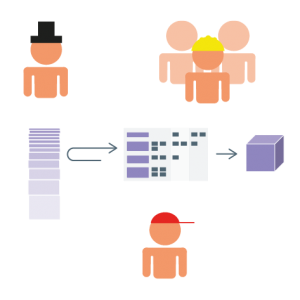P4 uses all elements of Scrum on the Team level and supplements them with additional elements. The Scrum terms were partially adapted in P4 in order to ensure a uniform structure of the terms with the additional levels (Cluster and Organization).
The following table gives an overview of the adapted terms and explains why they were changed.
| Scrum term | P4 term | Reason for change |
| Sprint | Iteration | Very often the term “Sprint” is misunderstood and teams think they need to perfrom one 100m sprint after the other. In reality we want the teams work with a sustainable pace, which is like a endurance run in sports. |
| Cycle | “Cluster Cycle” and “Organization Cycle” are pendants of the Iteration on higher level | |
| Sprint Backlog | Iteration Backlog | see above |
| Sprint Review | Team Review | Team Reviews take place after each Iteration. We don’t indicate Reviews by time but by the level of the organizational unit, in this case the Team. In P4 we have Reviews on all levels. To indicate the level of the Review we use the term “Team”, “Cluster” or “Organization”. |
| Sprint Retrospective | Team Retrospective | Team Retrospectives take place after each Iteration. We don’t indicate Reviews by time but by the level of the organizational unit, in this case the Team. In P4 we have Retrospectives on all levels. To indicate the level of the Retrospective we use the term “Team”, “Cluster” or “Organization”. |
| Product | Inspectable Results, Documented learnings, System increment | The term Product is more generic in P4. In most cases of physical product development, single teams are mostly not able to develop an entire system or product. That is why we have the term “System” on the Cluster level and the “Portfolio” of applications on the organization level. A minimum requirement for team results is that they must be inspectable. |
| Product Backlog | Team Backlog | see “Product” above. |
| Product Backlog Item | Team Backlog Item | see “Product” above. |
| Product Owner | Team Product Owner | With the above rules, we would have to introduce a “Team Owner”, which would be misleading. In addition the term “Product Owner” is so well known from Scrum that we decided to keep the term and just added the level (here: Team) |
| Daily Scrum | Team Sync | In P4 we have a recurring “Sync” (coordination meeting) on all levels, but more rarely on higher levels; so the term “daily” does not fit. To indicate the level of the Sync, we use Team, Cluster or Organization. |
| – | Team Improvement Backlog | Within the Retrospectives teams mostly find more improvements than they can work on in the subsequent Iteration. The Team Improvement Backlog stores those improvements to not forget about them and to not repeat them in each and every Retrospective. Representing improvements in the form of a Backlog has the advantage that the Team can prioritize the most important ones, and work on them in the upcoming Iteration. |
| – | Team System Engineer | The role is not necessary when there is only one team. With multiple teams in P4, there’s a needs for technical teams members on the Cluster level, who represent their teams in the Cluster groups and events. |
| Scrum Master | Team Scrum Master | There are Scrum Masters on all level (Team, Cluster, Organization). |
| – | Cluster … | Due to the scaled Scrum approach all Roles and Events on the Team level are repeated on the levels of the Cluster and the Organization. |
